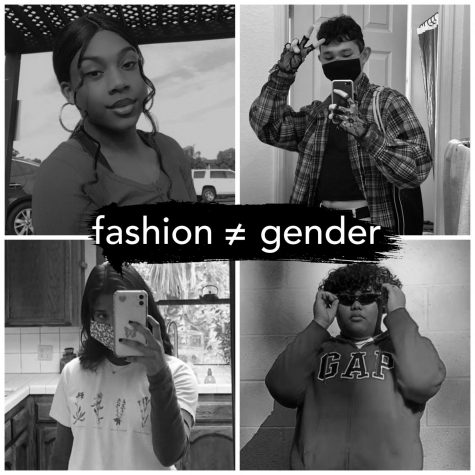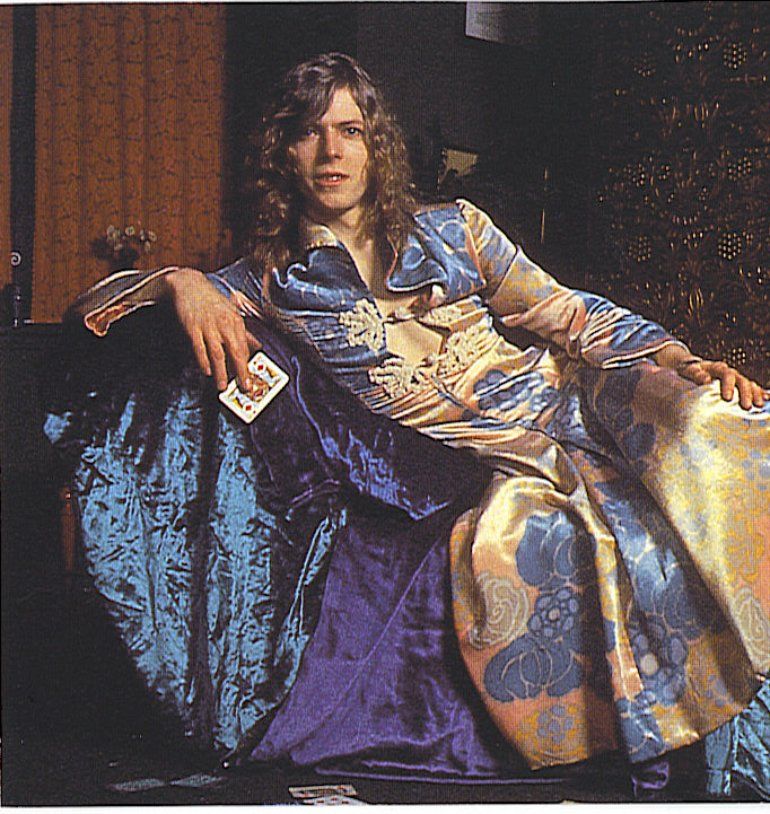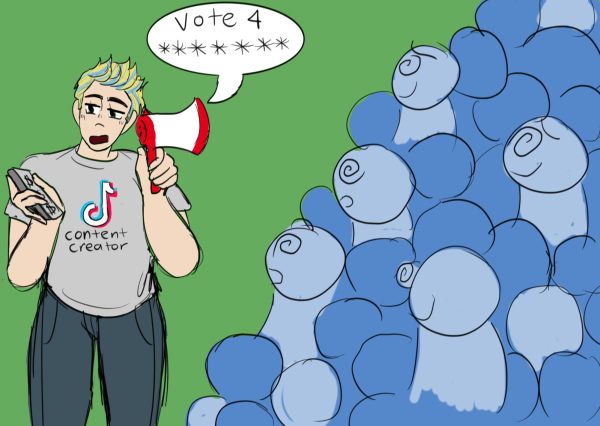Breaking barriers through fashion
Teens who defy gender norms deserve acceptance
David Bowie, Kurt Cobain, Young Thug, Jaden Smith and now Harry Styles; artists have been challenging the idea of gendered clothing for decades. Following the Vogue December 2020 magazine cover featuring Styles in a lace Gucci dress, the conversation surrounding what should be socially acceptable for men to wear continued. While many have praised Styles’ self-expression, some conservatives like American author Candace Owens continue to bash the British celebrity for continuing what she calls, “the steady feminization of our men.”
People too often criticize those who experiment with fashion in a way that does not follow traditional gender norms. This is especially true for men, who are expected to look masculine or risk being targeted by their peers. According to Mental Health America, LGBTQ+ teens, who are most frequently the students challenging gender norms, are nearly twice as likely to be called names, verbally harassed, or physically assaulted at school compared to straight, cisgender peers. Such bullying can be rampant on high school campuses, including Bonita Vista High (BVH).
This harrassment is rooted in sexism and homophobia and is based on arbitrary notions of what it means to ‘dress like a man.’ Bullying others for the way they present themselves is harmful and unjustifiable; therefore, students and teachers need to make BVH a safer place for students who defy gender norms through their clothing.
Judging people for being feminine is deeply rooted in sexist, heteronormative ideas. In most societies, women have traditionally been expected to tend to their homes and care for children while men work to provide for them. These roles have resulted in the modern stereotypes of women as sensitive, weak and unintelligent beings that depend on strong men to survive—effectively smearing women and erasing LGBTQ+ people. Alongside belittling women and femininity, these gender roles exclude queer people from social ideas of what is normal by suggesting that the two binary genders are the only valid ones and need each other to survive.
Due to this narrative, men are frequently viewed as having more wealth and power in society, and masculinity is treated as an asset. Feminine men often have their sexualities questioned by others or get bullied because they do not meet the masculine ideal.
“Women can dress like men because men have more power, [whereas] men don’t dress like women because that’s seen as emasculating and girly, and they’ll get punished for it,” Ph.D. candidate for Sociology at University of California, San Diego (UCSD) Haley McInnis said.
In short, McInnis and Ph.D. candidate in Sociology and Science Studies at UCSD, Catherine Crowder point out that from a sociological perspective, there is no reason for a man to want to look feminine since women are considered less powerful, which is why men being feminine often confuses people.
In accordance with societal norms, men are punished for attempting to defy gender norms because masculinity is seen as something valuable to protect, while femininity is a weakness. Even minor deviations from what is seen as “masculine” often lead to backlash against men.
“I’ve been really looking to get my ears pierced, but [my family] is really against anything feminine,” BVH senior Andre Ghashghaee said. Something as simple as a stud in his ears gets a strong reaction from people around him because it threatens his masculinity in their eyes.
Furthermore, according to Crowder, “You can look at masculinity, and similarly there is a lot more anxiety around ‘you’re not a real man’, [or] ‘that’s not fully masculine’ […] Masculinity is much more easily polluted than femininity in our envisioning of the two.”
Because of our strict envisioning of masculinity, men who dress slightly “feminine” are assumed to be weak by their peers or are called homophobic slurs, even if they identify as straight. People constantly discourage men from seeming feminine because, consciously or subconsciously, they see masculinity and being straight as a more valuable social commodity.
As a result of these sexist ideas, there is typically a sense of inhospitality towards anyone who does not identify as female wearing feminine clothes to school. In school environments, boys often intimidate or bully other boys for trying to experiment with their fashion choices. For instance, junior Mharck Cruz described trying to blend in after watching others be shamed for their fashion choices.
“It happens mostly with boys in the locker room,” Cruz said. “[People who dress feminine] are called slurs or are called these words that are meant to bring people down when they are just being themselves.”
Junior Frankie Lopez added, “When you put a boy in a skirt, it throws [other boys] for a loop, and their response to something that is different or doesn’t make sense to them is to attack and ostracize it.”
As Lopez explains, male students tend to make fun of femininity because they are raised to be masculine and suppress whatever feminine traits they do possess. McInnis elaborates “We move through the world with those ideas [taught to you] when you’re four: ‘Don’t throw like a girl.’ ‘That’s for girls.’ When we learn that at a really young age, we grow up to hold these [gendered] ideas. Then in the way that we speak, behave and interact with other people we end up reinforcing it, even if we’re not aware that we’re doing it.”
While parents may not explicitly say that being masculine is better than being feminine, small comments like those mentioned by Lopez can subconsciously teach children sexist concepts. Similarly, when one student makes fun of another for being feminine, they are furthering a misogynistic agenda, whether they realize it or not.
This feeling of seeing femininity as shameful also affects girls. For example, junior Sophia Ramirez described how being feminine is accompanied by bad connotations of unintelligence and weakness.
“I was considered a tomboy in elementary school because I was really athletic, […] but it sucks that I had to feel good by not being feminine” Ramirez said. “I do also deal with internalized misogyny—how people are so afraid to be feminine and how it is perceived as bad.”
As McInnis stated, the stereotype that women are weaker is taught to little girls too. Some girls feel the need to downplay their own femininity and are rewarded by peers and adults for being more ‘masculine and strong,’ even though femininity is not weak or inferior in the first place. These stereotypes of femininity are extremely harmful to people’s perception of women and men who dress in a feminine manner.
The way clothes are gendered—and the fact that they are gendered in the first place—are just social constructs. The concepts of ‘femininity’ and ‘masculinity’ have and will continue to change. For example, Crowder stated, “In the Victorian era, baby boys in wealthy families wore pink. And now pink is a baby girl color, right? So there’s a certain arbitrariness to the signals that get sent out.” Because people can change what clothing they associate with a particular gender, the clothing in itself has no ‘true’ meaning at all.
Given the fact that clothing has no inherent gender, people of all genders should be free to dress however they want without being harassed. In Vogue’s Playtime with Harry Styles, Styles states, “It’s like anything—anytime you’re putting barriers up in your own life, you’re just limiting yourself. There’s so much joy to be had in playing with clothes. I’ve never really thought too much about what it means—it just becomes this extended part of creating something.”
While some still argue that distinctions between clothing for each gender are necessary, that is a complex debate. Styles believes that gender should be irrelevant when considering the clothing that is acceptable for people to wear.
In support of this statement, Crowder elaborated, “You can’t really have an honest conversation about what’s okay for who to wear without at least tangentially having a conversation about what’s a good society? What are our values? How do we want our market activity and our cultural beliefs to interplay with each other? How do we want our intimate relationships to work? How do we want our families to work? In some ways, this is very legitimately an issue that’s really personal for people.”
The truth is, everyone answers these questions differently. Regardless of what one’s answer is, it does not give anyone the license to be uncivil and disrespectful to those who present differently.

Although gender norms are still embedded into our society, we should respect people’s choices of dress regardless of their gender. Working towards making schools more accepting, building kinder social circles and being open to different ideas helps make students who do not follow gender roles feel safer to explore their identities.
Senior Luke Svehaug elaborated on how dressing feminine was tough, especially during classes. They explain that although they did not face many explicitly negative comments, the stares from classmates made them feel less confident. However, they also experienced confidence-boosting comments from other peers that allowed them to continue their exploration of their fashion sense and gender.
“I’ve had a lot of positive things [comments] from my friends—it was mostly the girls though. But a lot of proud comments were encouraging [me],” Svehaug said.
For people who are trying to expand their fashion style into feminine territories, having an open-minded environment helps with not only confidence but also helps fight potential fear about criticism.
“Once I knew I had a good support structure for who I could be [I thought], ‘Okay, time to start cranking things up.’ I started wearing crop tops [and] women’s clothing,” senior Brandon Stigall said.
While men are still criticized for wearing dresses or painting their nails, there is still potential to build a more accepting society that allows people to explore fashion regardless of their gender.
Positive media representation of men like Styles that ignore gender fashion conventions, has slowly nudged public opinion towards acceptance.
“With celebrities endorsing a more fluid presentation, there’s absolutely the possibility that it could be shifting expectations, changing norms [and] starting to complicate the gender ideology in the minds of consumers who are seeing these magazines,” Crowder said.
In support of Crowder’s statement, Cruz emphasized the importance in his personal life of media representation of men dressing in a feminine manner. In response to Styles’ Vogue cover, Cruz recalled thinking, “Wow, there’s this example of someone who I can be and a place where I won’t be judged for it.”
While pop culture has certainly paved the way for conversations about gender and fashion, it is up to everyone to foster a safe environment for the average person to dress how they want to. By being confident in one’s own individuality and kind towards the individuality of others, communities become more accepting.
“If me walking down in a little crop top [with] a handbag makes someone so angry that they have to say something, I’m living in their mind rent-free; that’s a win for me and [ultimately boosts my] confidence,” Stigall said. “It’s [my] way to show other people who are against [the] feminization of men. I’m showing them that we’re here.”

Hi! I'm currently a junior and this is my first year in newspaper. Journalism interests me because of its importance to readers and media in general. Before...

I’m a junior this year and this is my first year on staff. I find newspaper to be an interesting course that touches on a variety of topics, including...




![Associated Student Body (ASB) President and senior Nicole Hill likes to work in her bedroom and then move to her kitchen once the house is quiet and empty. Hill prefers a change in scenery since “it's hard [for her] to just focus in one spot the entire day.”](https://bonitavistacrusader.org/wp-content/uploads/2020/12/IMG_7949-300x225.jpg)




Jared Phelps • Jan 16, 2021 at 7:33 am
Thank you so much for writing this piece! Our clothing/accessories are an important tool for us in feeling comfortable/ourselves in the world. I don’t remember this being a part of the conversation at all when I was in school (too many years ago), so I’m glad to see it being discussed now in an effort to allow more people to feel comfortable in their bodies. I’ve been idly thinking of adding skirts and dresses to my wardrobe for years, and this article might be the thing that encourages me to make my first purchase!